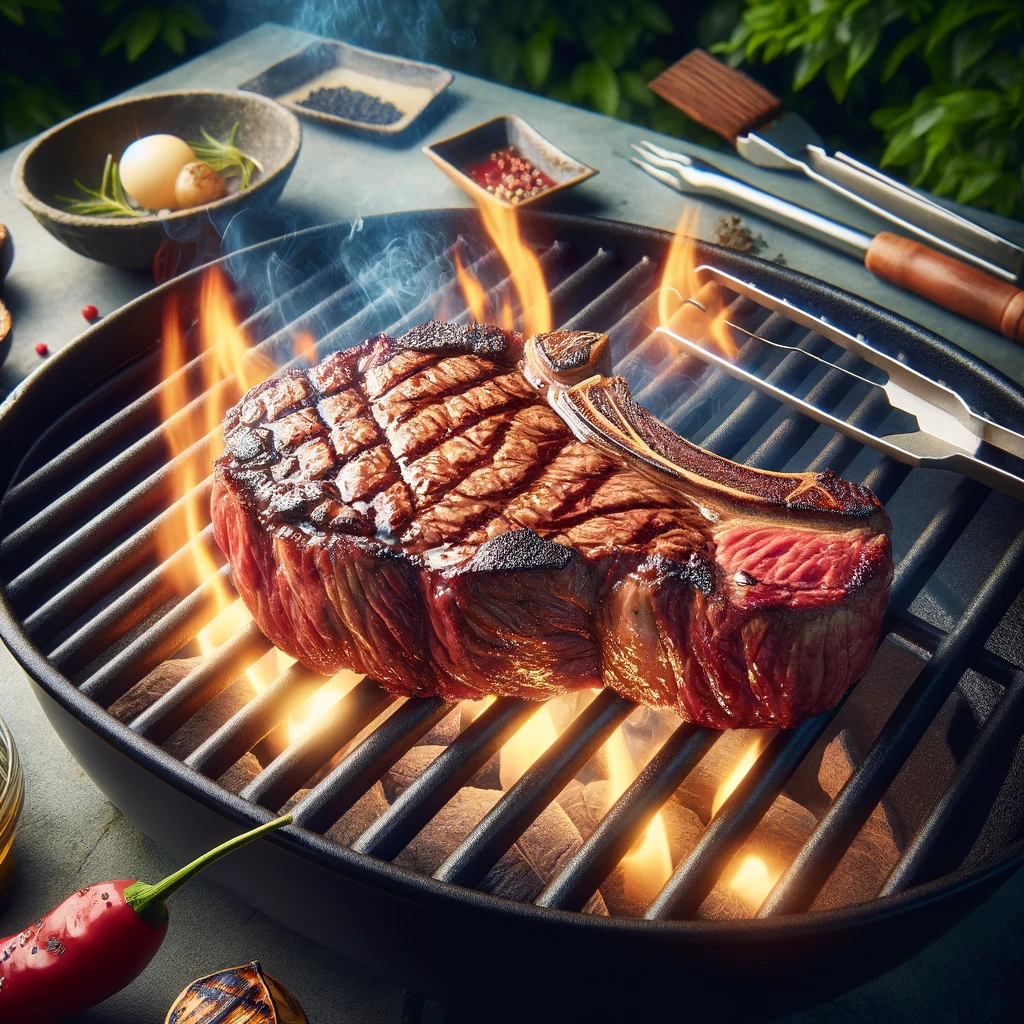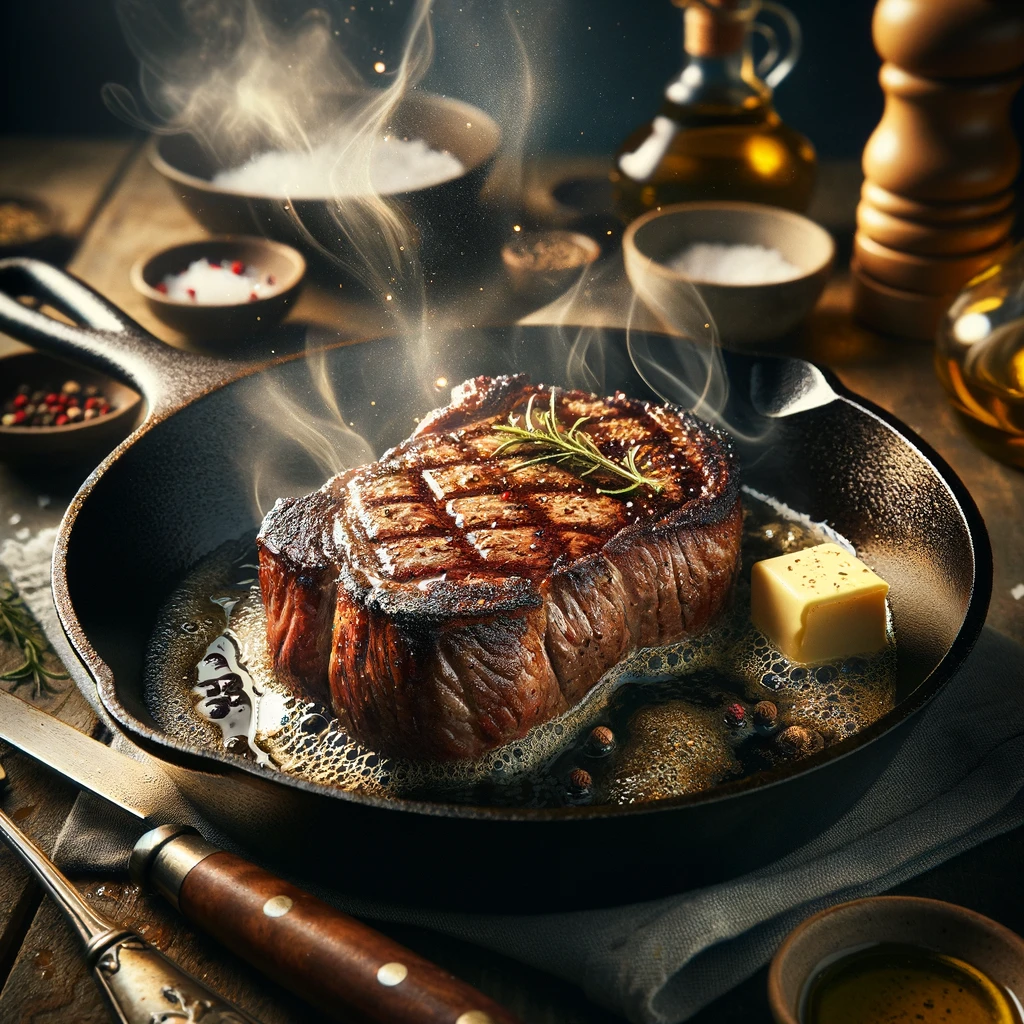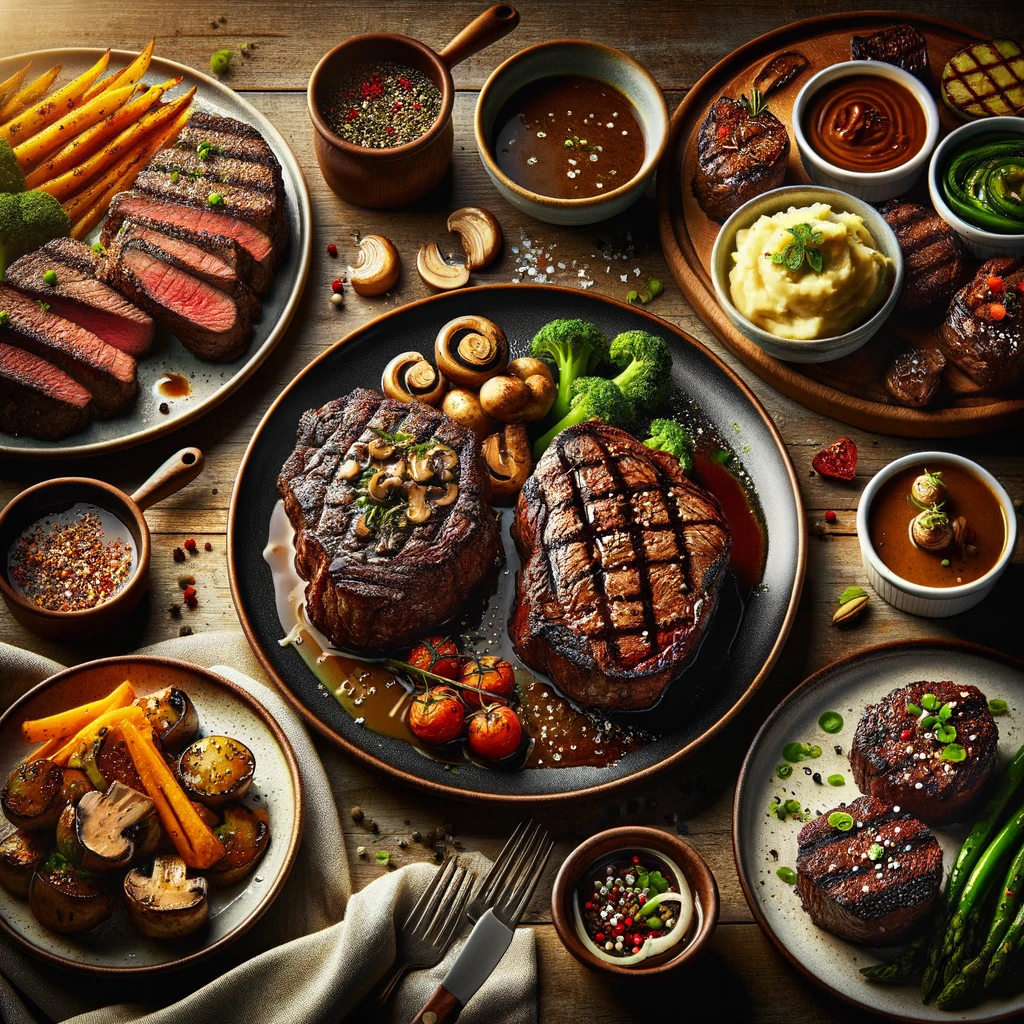Part 1: Unveiling the Petite Sirloin Steak
The Petite Sirloin: A Savory Star for Any Meal
The Petite Sirloin Steak world offers a treasure trove of cuts, each with its own personality. Among these, the petite sirloin shines as a fantastic choice for both budget-minded cooks and flavor seekers. Often overlooked for pricier cuts, the petite sirloin holds its ground with impressive taste and surprising versatility.
This cut, from the cow’s back, is prized for its delightful balance of leanness and flavor. While not the most tender, it offers a satisfying chew and rich beefy taste that thrives with simple preparations or bold marinades.
Don’t be fooled by the “petite” name! This steak comes in various sizes, feeding your cravings for a quick weeknight dinner or a flavorful addition to your next barbecue. It’s a cut you can rely on.
Get ready to explore the culinary potential of this underappreciated steak. Next, we’ll dive into the benefits of choosing petite sirloin and equip you with tips to transform it into a delicious and satisfying main course.
Why You Should Love Petite Sirloin
Love delicious, budget-friendly steaks? Look no further! Here’s why petite sirloin deserves a spot on your grill:
- Value: Amazing flavor at a fraction of the cost of pricier cuts.
- Lean & Nutritious: Packed with protein, low in fat – a healthy, balanced meal.
- Quick & Easy: Cooks up beautifully in a short time, perfect for busy nights.
- Flavorful & Versatile: Absorbs marinades and spices, allowing for endless flavor creations.
Affordable, nutritious, and flexible, the petite sirloin is a compelling choice for any steak lover. So next time you’re at the butcher shop, give this delicious cut a try!
Part 2: Preparing Your Petite Sirloin Steak

Selecting the Best Petite Sirloin Cuts
Not all petite sirloins are created equal. Here’s how to choose the perfect one for a delicious steak:
- Color: Look for a bright red steak with good marbling throughout. Marbling is the white flecks of fat within the muscle. It adds flavor and juiciness during cooking.
- Thickness: Aim for a steak around 1-inch thick. This ensures even cooking and allows you to achieve your desired level of doneness. Thinner steaks can dry out quickly.
- Firmness: Gently press the steak with your finger. It should feel firm but have a slight give. Avoid steaks that are too soft or mushy.
- Freshness: Ask your butcher when the steak was cut. Ideally, you want a fresh cut within a few days.
By following these tips, you’ll be well on your way to selecting a flavorful and tender petite sirloin steak.
“For those looking to explore more cooking methods, our Crispy Air Fryer Chicken offer a healthier twist on a classic favorite”
Essential Ingredients for Enhancing Flavor
A simple seasoning can elevate your petite sirloin to new heights. Here are some key ingredients to have on hand:
- Salting: Salt is crucial for drawing out the natural flavors of the steak. Season generously, but avoid overdoing it. Apply salt at least 30 minutes before cooking for best results.
- Black Pepper: Freshly ground black pepper adds a classic steakhouse flavor. Grind it just before cooking for the most aroma and bite.
- Garlic Powder/Onion Powder: These add a touch of savory depth without overpowering the steak’s natural taste.
- Herbs: Rosemary, thyme, and oregano complement beef beautifully. Use them dried or fresh, depending on your preference.
- Olive Oil: A high smoke point oil like olive oil is perfect for searing the steak. It adds a subtle richness without burning.
- Optional: Experiment with other flavorings like smoked paprika, cayenne pepper, or even a sprinkle of coffee grounds for a unique twist.
Remember, the best approach is to start simple and adjust the seasonings to your liking.
Marination Techniques for Tender Steaks
Marinades are a great way to add extra flavor and tenderness to your petite sirloin. Here’s how to create a delicious marinade and use it effectively:
- Acidic Base: Most marinades rely on an acidic component like vinegar, lemon juice, or yogurt. This helps break down the muscle fibers, resulting in a more tender steak.
- Flavor Builders: Incorporate complementary flavors like garlic, herbs, spices, and even a touch of sweetness (honey, brown sugar) to create a well-rounded marinade.
- Marinating Time: Marinate your petite sirloin for at least 30 minutes, but no longer than 24 hours. Marinating for too long, especially with acidic ingredients, can make the steak mushy.
- The Process: Combine your chosen marinade ingredients in a bowl or zip-lock bag. Add the steak, ensuring it’s fully submerged. Refrigerate during marinating.
- Discard the Marinade: Do not reuse marinade that has been in contact with raw meat to avoid spreading bacteria. Discard it after removing the steak.
A Simple Marinade Example:
Combine olive oil, soy sauce, lemon juice, minced garlic, chopped rosemary, and a pinch of brown sugar. Marinate your petite sirloin for 1-2 hours for a flavorful and tender steak.
With these tips and techniques, you’re well on your way to preparing a show-stopping petite sirloin steak!tunesharemore_vert
Part 3: Mastering the Petite Sirloin
Now that you’ve discovered the petite sirloin’s potential, let’s explore how to transform it into a restaurant-worthy main course. Here, we’ll delve into three popular cooking techniques: grilling, pan-searing, and oven-roasting. Each method unlocks unique flavors and textures, allowing you to create the perfect steak experience.
Grilling the Perfect Petite Sirloin

Fire up the grill! Grilling is a classic way to cook petite sirloin, infusing it with a smoky flavor and beautiful char marks. Here’s how to achieve grilling perfection:
- High Heat & Sear: Preheat your grill to high heat. Sear the steaks for 1-2 minutes per side to lock in juices and create a flavorful crust.
- Indirect Heat for Doneness: Once seared, move the steaks to an indirect heat zone (cooler part of the grill) to finish cooking. Use a meat thermometer to ensure your desired doneness (135°F for medium-rare).
- Rest for Flavor: After grilling, let the steaks rest for 5-10 minutes. This allows the juices to redistribute, resulting in a more tender and flavorful steak.
Tips for Grilling
- Marinate for Extra Flavor: Enhance the taste with a marinade for 30 minutes to an hour before grilling.
- Clean and Oil the Grates: Clean your grill grates to prevent sticking and lightly oil them to ensure even cooking.
- Don’t Press the Steak: Resist the urge to press down on the steak with your spatula, as this squeezes out precious juices.
“Expand your culinary repertoire with our 15 Must-Try Kielbasa Recipes.”
Pan-Searing for Optimal Flavor

Pan-searing offers a quick and convenient way to cook a delicious petite sirloin. This method creates a stunning crust while keeping the inside juicy and flavorful. Here’s how to pan-sear like a pro:
- High Heat & Sear: Heat a cast-iron skillet over high heat. Sear the steaks for 2-3 minutes per side for a deep golden brown crust.
- Flavor Boost with Butter & Herbs: After searing, add butter, garlic, and your favorite herbs to the pan for a flavor-packed sauce to baste the steaks.
- Finish to Desired Doneness: Reduce heat and cook the steaks to your desired internal temperature, using a meat thermometer for accuracy.
Best Practices
- Pat Dry for a Perfect Sear: Pat the steaks dry with paper towels before searing to ensure a nice crust.
- Use the Right Oil: Opt for an oil with a high smoke point, like avocado oil or grapeseed oil.
- Don’t Crowd the Pan: Don’t overcrowd the pan. Cook the steaks in batches to maintain proper heat for a good sear.
We’ll explore oven-roasting techniques next, providing you with another excellent way to cook a delicious and tender petite sirloin steak
Part 4: Petite Sirloin Recipe Showcase
Now that you’ve mastered the cooking techniques, let’s put them into action with some delicious recipe ideas! Here, we’ll present three inspiring dishes featuring the versatile petite sirloin:
Classic Grilled Petite Sirloin Recipe
This recipe keeps things simple, allowing the natural flavor of the steak to shine.
Ingredients:
- 2 petite sirloin steaks (about 6-8 oz each)
- Kosher salt
- Freshly ground black pepper
- Olive oil
Instructions:
- Preheat your grill to high heat. Pat the steaks dry with paper towels. Season generously with salt and pepper.
- Sear the steaks for 1-2 minutes per side for a nice char.
- Move the steaks to an indirect heat zone and cook to your desired doneness (about 4-5 minutes per side for medium-rare).
- Let the steaks rest for 10 minutes before slicing and serving.
Herb-Infused Pan-Seared Petite Sirloin
This recipe infuses the steak with a burst of fresh herbs for a flavorful twist.
Ingredients:
- 2 petite sirloin steaks (about 6-8 oz each)
- Olive oil
- Salt
- Pepper
- 2 cloves garlic, minced
- 1 tablespoon fresh thyme leaves
- 1 tablespoon fresh rosemary leaves
- 1 tablespoon butter
Instructions:
- Pat the steaks dry and season with salt and pepper. Heat olive oil in a cast-iron skillet over high heat.
- Sear the steaks for 2-3 minutes per side for a deep brown crust.
- Add butter, garlic, thyme, and rosemary to the pan. Baste the steaks with the herb butter for a minute.
- Reduce heat and cook to desired doneness. Once cooked, let the steaks rest for 5 minutes before slicing.
Oven-Roasted Sirloin with Vegetables
This recipe creates a complete and satisfying meal with tender steak and roasted vegetables.
Ingredients:
- 2 petite sirloin steaks (about 6-8 oz each)
- 1 tablespoon olive oil
- Salt
- Pepper
- 1 red bell pepper, sliced
- 1 yellow onion, sliced
- 1 cup baby potatoes, halved
- 1/2 cup beef broth
Instructions:
- Preheat oven to 400°F (200°C). Toss vegetables with olive oil, salt, and pepper. Spread on a baking sheet.
- Season the steaks with salt and pepper. Place them on top of the vegetables.
- Pour beef broth into the bottom of the pan. Roast for 20-25 minutes, or until steaks reach desired doneness and vegetables are tender.
These are just a few examples to get you started. With the knowledge and techniques you’ve gained, explore endless possibilities and create your own signature petite sirloin dishes!
Part 5: Pairings and Side Dishes
Wine Pairings for Petite Sirloin
A well-chosen wine can elevate your entire steak dinner experience. Here are some perfect pairings for your petite sirloin:
- Medium-bodied Reds: Since petite sirloin is leaner, opt for wines with moderate tannins that won’t overpower the delicate flavor. Pinot Noir, with its notes of red fruit and earthiness, is a classic choice. Merlot and Cabernet Franc are also excellent options.
- Bold Reds (Optional): If you prefer a bolder red, consider Malbec with its dark fruit and spice notes, or a Zinfandel for its rich berry flavors. However, ensure the wine doesn’t overpower the subtler taste of the petite sirloin.
Tips:
- Consider the cooking style and any sauces you’re using when selecting a wine.
- Don’t be afraid to experiment and find a pairing you enjoy!
Vegetable Sides to Complement Your Steak
The right vegetables can add color, freshness, and nutritional balance to your steak dinner. Here are some delicious options:
- Roasted Vegetables: Roasting vegetables like broccoli, asparagus, Brussels sprouts, or bell peppers brings out their natural sweetness and caramelizes them for a delightful flavor.
- Grilled Vegetables: Zucchini, onions, mushrooms, and eggplant all hold up well to grilling and add a smoky touch to your meal.
- Sautéed Greens: Sauteed spinach, kale, or Swiss chard with a touch of garlic and olive oil provide a healthy and vibrant side dish.
Starch-Based Sides for a Hearty Meal
A comforting starch completes your steak dinner and satisfies your hunger. Here are some popular choices:
- Mashed Potatoes: Creamy mashed potatoes offer a perfect textural contrast to the steak. For a lighter option, try mashed cauliflower.
- French Fries: Crispy French fries are a classic steakhouse pairing. Opt for baked or air-fried versions for a healthier alternative.
- Roasted Sweet Potato: Roasted sweet potatoes with a touch of herbs or spices add a touch of sweetness and complex flavor to the meal.
- Rice: Steamed white rice or brown rice provides a neutral base that allows the steak to shine.
- “Complement your healthy steak meal with our Ultimate Chicken and Artichoke Recipe., a deliciously healthy delight”
Remember:
- Choose sides that complement the flavors of your chosen marinade or sauce.
- Consider portion sizes to avoid overwhelming your guests.
With these pairing and side dish ideas, you can create a truly delicious and satisfying meal centered around your perfectly cooked petite sirloin steak.
Part 6: Petite Sirloin Perfection – Cooking Like a Pro
Now that you’ve explored techniques and recipes, let’s delve into some advanced tips to elevate your petite sirloin game to restaurant quality.
Achieving the Perfect Doneness
Cooking a steak to your exact preference is an art form. Here’s how to master the art of doneness with petite sirloin:
- Internal Temperature is Key: Invest in a good instant-read meat thermometer. This is your ultimate tool for achieving perfect doneness. Here’s a guide:
- Rare: 125°F (52°C)
- Medium-Rare: 135°F (57°C) – Most recommended for petite sirloin for optimal tenderness and flavor
- Medium: 145°F (63°C)
- Medium-Well: 155°F (68°C)
- Well-Done: 160°F (71°C)
- Let the Steak Come to Room Temperature: Take the steaks out of the refrigerator 30 minutes before cooking. This ensures even cooking throughout.
- Sear for Flavor, Not Finish: The sear is for creating a flavorful crust, not necessarily indicating doneness.
Resting Your Steak: Why It’s Crucial
Resting your steak after cooking is absolutely essential. Here’s why:
- Redistribution of Juices: When you sear a steak, the juices get pushed towards the surface. Resting allows these juices to redistribute throughout the meat, resulting in a more tender and flavorful steak.
- Carryover Cooking: The internal temperature of the steak will continue to rise slightly even after removing it from heat. Resting accounts for this carryover cooking, ensuring you don’t overcook your steak.
The resting time depends on the thickness of your steak, but generally aim for 5-10 minutes. Tent the steak loosely with foil to trap heat while it rests.
With these advanced tips in your arsenal, you’re well on your way to becoming a petite sirloin master!
Part 7: FAQs
Q: What are petite sirloin steaks good for?
A: Petite sirloin steaks are a versatile and budget-friendly cut of beef. They are perfect for:
- Quick and easy meals: Petite sirloins cook quickly due to their smaller size, making them ideal for weeknight dinners.
- Grilling: They sear beautifully on the grill, developing a delicious smoky flavor.
- Marinades: Their leanness makes them receptive to marinades, allowing you to infuse them with extra flavor and tenderness.
- Salads: Sliced thin, they can be a protein addition to a hearty salad.
Q: What is the best way to tenderize petite sirloin steak?
A: Here are some methods to tenderize your petite sirloin:
- Marinate: As mentioned earlier, marinades with acidic components like vinegar or lemon juice help break down muscle fibers, resulting in a more tender steak.
- Mechanical Tenderization: Use a meat mallet to physically tenderize the steak. This disrupts the muscle fibers, making them shorter and easier to chew.
- Brining: Soaking your steak in a salt solution (brine) for a short time can help tenderize it and add moisture.
Q: What is the best cooking method for sirloin steak?
A: There’s no single “best” method, but here are some popular options for petite sirloin:
- Pan-Searing: This method provides a flavorful crust and juicy interior.
- Grilling: Grilling offers a smoky flavor and beautiful sear.
- Broiling: Broiling cooks the steak quickly and evenly, perfect for achieving a desired doneness.
The best method depends on your preference and desired outcome.
Q: Is petite sirloin chewy?
A: Petite sirloin can be chewier than some other cuts due to its leanness. However, with proper preparation techniques like marinating, tenderizing, and using the correct cooking method, you can achieve a tender and flavorful steak.tunesharemore_vert
Conclusion: Unleash the Potential of Petite Sirloin
The unassuming petite sirloin has emerged from the shadows, transformed from an overlooked cut to a culinary star in your kitchen. Throughout this guide, you’ve explored its potential, learned essential cooking techniques, and discovered delicious recipes to turn this affordable steak into a show-stopping main course.
Remember, the key to petite sirloin mastery lies in understanding its characteristics and applying the right techniques. Embrace the versatility of this cut – grill it for a smoky char, pan-sear it for a juicy and flavorful bite, or roast it for a complete and satisfying meal.
So, the next time you’re at the butcher shop, don’t be afraid to experiment with the petite sirloin. With the knowledge and confidence you’ve gained from this guide, you’re well on your way to creating restaurant-worthy steak experiences at home. Explore endless flavor combinations, hone your cooking techniques, and most importantly, have fun in the kitchen!
USDA Guidelines on Beef – “USDA beef preparation guidelines”


1 thought on “Petite Sirloin Steak: The Underrated Cut for Delicious & Easy Meals”
Comments are closed.